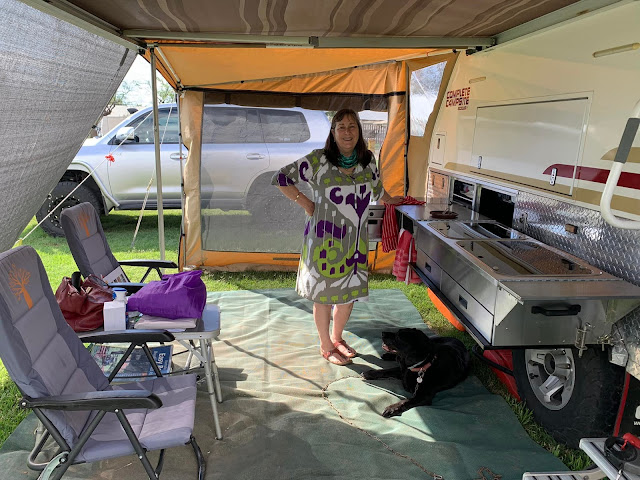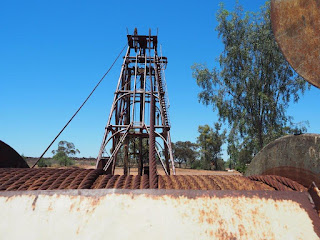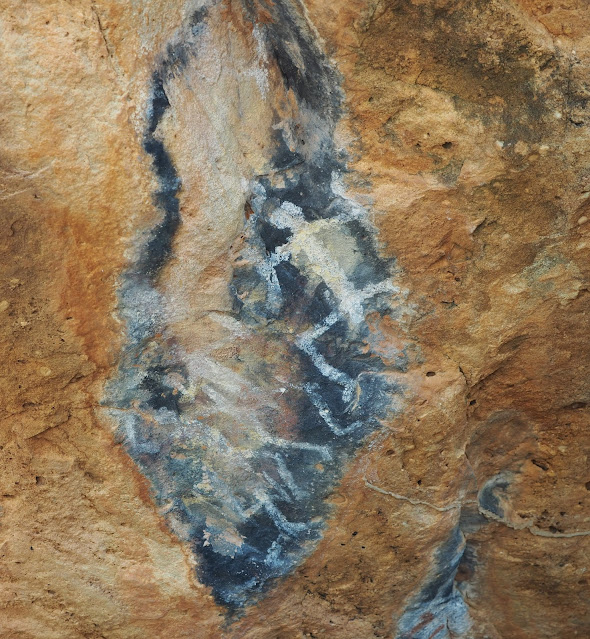Cobar
Gilgandra to Cobar
“The road is straight, not straight like an arrow, you will still have to go around corners”.
I giggled in memory of this statement delivered to us when we were getting directions to exit out of Dublin several years before.
Well, the road to Cobar is just like that, it is flat and dead straight snaking up and down over hills away into the distance as far as the eye can see. In some parts in the big open plains, you can actually see the curve of the earth as it is so vast out here. Big puffy clouds hang way up in the sky like big cotton buds and the morning heat simmered of the bitumen as we made our way toward Cobar.
It is a 3 hr 6 min (294 km) trip from Gilgandra via Oxley Hwy and A32. We stopped for lunch in Nyngan and pulled up into the park and I extended the awing so we could prepare lunch in the shade.
Summer is finally starting to kick now, and we are getting some really hot days. The temperature control in the truck make it feel very comfortable however when you get out of the air conditioning the hot temperature hits you like a blast furnace. Bit of a change from chilly Katoomba for us and Sharon swelters in the heat.
Cobar is a town in central western New South Wales, Australia whose economy is based mainly upon base metals and gold mining.
The welcome sign just outside of Cobar is a huge monument depicting the mining history and makes a great photo opportunity.
We pulled into Cobar Caravan park after lunch (it is a Gyday rewards park 10% discount up to max $50) Sharon has joined several of the caravan parks so we can take advantage of the discounts on offer. This has proved to be a great idea and has saved us quite a lot of money over the years.
The park is located at 101 Marshall St Cobar NSW 2835 PH: 02 6836 2425 RECEPTION OPEN 7 Days 9:30am – 5:30pm
All the powered sites have a large concrete pad complete with water and sullage on hand. We were given a site which was quite open with no shade however we had plenty of space and privacy. I set up the van and Sharon helped me to set up the entire annex and shade screens. This is the first time we have ever done this, and I wanted to get the full experience of how they performed and what they offered. The final result was just fantastic. We essentially had a big room at the side of our van which was cool and shady and made the outdoor cooking a breeze.
The amenities in the park were spotless however after dark and in the intense heat they filled up with rather large insects which are impossible to keep out. I turned on the taps in the sink to wash my hands and jumped back as two large bugs the size of my thumb popped up out of the drain startling me. Not really an issue out here when you get used to it, but a bit of a shock the first time
Before making dinner, we took a drive through Cobar which has a long main street and in the evening like many outback towns resembled a ghost town.
After dinner we settled down in our outdoor tent and relaxed in the evening heat. There was not a breeze, and everything felt quite serene. Cobar is to be a three-night stopover for us as we had lots of things on our itinerary to check out.
Around 1 am in the morning I awoke abruptly to a snap as the van moved under me. Instantly awake now I heard the wind howling outside and suddenly the annex which was put up with so much love and assistance from Sharon started flapping like the sail on a boat making the whole van sway a little. Fearing I would lose the entire annex I shot up out of bed to inspect what was going on. Outside the calm conditions had turned very nasty and the wind was howling through the campsite. We were on a very exposed site and were getting the full brunt of the force. The wind had knocked over the poles on the main and side annex and they were wildly flapping. The guide ropes were no match for the strong wind and simply flailed around still attached to the annex. Still in my Y fronts I started to dismantle the annex however had to get Sharon up to assist as it was just too wild for one person. I later noticed that all the other vans in the park had removed awnings and annex giving me the impression that this was not an uncommon event here. We managed to remove the annex and I rolled up the awning and chucked the whole lot under the caravan and returned to bed and we were asleep in an instant.
During our three days stay in Cobar I think we seen everything there is to see in this little town. Here are a few of the places we visited
Our first stop was the Information centre located in the Mining heritage museum on the outskirts of town. Sharon did not join me as we have been to so many mines its hard to keep her interested. Preferring instead to stay in the cool climate control of the truck along with Gemma, I left them and with my camera made my way into the centre.
Behind the museum are lots of relics from the first copper mines founded in Cobar in 1870 which was later merged to create the Great Cobar Copper Mine. The remains of the mine are still there, and the hole is now filled with water and fully fenced. I read they had to fence it off as the whole place had become a home to the feral goats and also had become a dangerous playground for the local kids. So much history right here in this little town. I purchased a
T-shirt and some magnets for our fridge in the museum on my way out and collected Sharon and Gemma so we could go for a walk.
 |
| Plough at the back of the Museum |
 |
| Paddy & Duffy - Two Convertors named after Mayors in Cobar |
Across the road from the heritage centre is the Cobar Miners Heritage Park, an outdoor area with a collection of items from the region’s mining history. The park is a memorial for the people who have been killed working in the mines, but it is also designed to be educational. The many names in the memorial suggest a dangerous life in the mines at that time. One can only imagine the horrors of being stuck down a mine breathing in all that dust in those times. Apparently lots of miners died many years after mining due to the dust and their deaths were never recorded.
 |
| Some of the many names of deceased miners |
We drove up to Fort Bourke Hill Lookout, just out of town.
I noticed a car and caravan following me as we made the ascent into the narrow neck entry and Sharon commented that some people just refuse to obey the signs which clearly state no caravans. Luckily there was room at the top for them to turn and not have to back down that hill.
From the viewing platform, you can look down into the New Cobar Gold Mine which is still operational, and I took lots of photos with my camera.
Just a little further out of town, there is another operational mine – the Peak Gold Mine.
We took a walk into the town, and I got some photos of the Great Western Hotel, which is said to have the longest pub balcony in New South Wales, or the longest wrought-iron balcony in the Southern Hemisphere (depending on who you ask). I think this claim could be challenged as we have been to many towns which make similar claims
The other pub of merit is the Grand Hotel and its contribution to Australia’s collection of ‘big things’. It is hard to miss as it has the Big Beer Can, sitting on top of its veranda.
We made a drive just out of town (everything in Cobar is very close) to see the New reservoir and old reservoir which were deserted on our visit. The other area we were advised to see was the Devils Rocks which is an important site for the local Indigenous people. The road to it is a bit sketchy but we persisted only to find that the Devils Rock was so badly graffitied that I didn’t even bother to take a photo of it. On the return back to the highway and much to Sharon’s dismay I done a little 4x4 hill which did manage to raise the heartbeat a little.
MOUNT GRENFELL HISTORIC SITE
Mount Grenfell. It’s about 70 km away (it’s about 30km off the highway).
70km down the highway on the road toward Broken hill we found the turnoff to Mt Grenfell Historic Site. When we got there the dirt road turnoff had a "Road Closed" sign and barrier. This was very disappointing as we had made this journey all the way especially just to see this and there was noting in the media or other to suggest it was closed. We decided to investigate the closure as we had come so far so i swung around the barrier and the dirt road in front of us was like a superhighway as it was literally 4 lanes wide and recently graded. Around 20km further along the road was still pristine and had not disentigrated. Shortly after that we met a grader and truck and i thought we may get challenged about driving however the driver waved us through so we continued to the turnoff to the Historic site (approx 30km from the main road). We had not passed another vehicle the whole way and the road was simply fantastic. Why had they closed it? who knows but i am glad we decided to be a bit cheeky on this occasion as the Historic site turned out to be a fantastic step back in time.
We pulled into the carpark and found we had the whole place to ourselves. The amenities were clean long drops and there was water. I made lunch and we set off to view some of the rock art
Mount Grenfell has one of the most important collections of Indigenous rock art in the country. On the caves, there are about 1300 different images, telling the stories of life in the region for millennia.
We thoroughly enjoyed this and happy we made the 140km round trip. It was a very memorable experience



















































